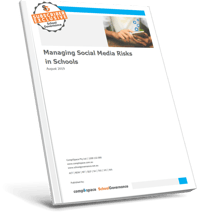In the first part of this article we discussed the obligation of staff not to negatively impact on the reputation of their employer in their personal use of social media. We now look at the responsibilities of the school in relation to protecting its staff from some of the hazards of social media and seeking to ensure a child safe environment.
Harassment, Discrimination and Bullying - Staff
Schools are no different to other employers in that social media tools are providing new and different forms of communication for staff members which in turn result in new risks and hazards for the employer.
For a school, there are probably two main sources of harm to school staff arising out of social media: bullying and harassment by other staff, and bullying and harassment from students, parents and carers.
These days it would be hard to argue than an employer should ignore an employee who stalks, harasses, or makes threatening or offensive comments on social media about, another colleague or their manager. Additionally, in the school context, parents/carers and students have been known to be even more outspoken in their criticisms and abuse of teachers and other school staff. Clearly, such behaviour can have a significant impact on the workplace even though it occurs after hours - the effect on workplace relations, staff wellbeing and health, productivity and educational outcomes cannot be overstated.
If the potential disruption to the school’s operations is not sufficient to motivate action by a school in these circumstances, workplace health and safety legislation across Australia is clear that an employer has a legal duty of care to take reasonably practicable measures to eliminate or minimise the risk of harm to its workers arising out of their work. Under anti-discrimination legislation at federal and state/territory level, an employer can be held vicariously liable for discrimination or harassment that occurs in the workplace or in connection with a person’s employment if they have not taken all reasonable steps to prevent the discrimination or harassment occurring and not responded appropriately to resolve incidents. A similar approach is taken by the Fair Work Commission under its anti-bullying jurisdiction in relation to bullying.
The question that arises in relation to social media is how far that duty of care extends beyond the school bell and the school gate. So what “reasonable steps” should a school take to eliminate or minimise the risk of harm to its employees arising out of after hours use of social media?
In the context of social media, the school as an employer must have a general policy addressing prevention and management of bullying and harassment and should have a social media policy for staff. The social media policy should clearly set out that bullying, harassment or other offensive posts by staff in relation to any member of the school community will not be tolerated, that breaches can result in disciplinary action, and that the policy extends to personal use of social media. These policies must be supported by mechanisms to report and manage complaints and provide prompt and appropriate responses, as well as training to ensure all staff and supervisors are aware of their responsibilities.
With respect to bullying and harassment of staff by parents/carers, the school has the same duty of care to protect their staff, although what constitutes “reasonable steps” is more complicated. A parent “code of conduct” should be considered, which would set out expectations of respectful behaviour and a statement that bullying, harassment and abuse of staff, whether face-to-face or online, will not be tolerated. If the parent code of conduct is instituted as part of the enrolment process, this may be used as a condition of the student’s continuing enrolment. A parent code of conduct which is instituted after enrolment can still have considerable weight; having such a code would be considered a “reasonable step” to protect staff. The school should seriously consider the sanctions that should be applied where parents persist in breaching the parent code of conduct, as part of the “reasonable steps” requirement.
To reduce the incidence of parental ‘bad behaviour’ on social media it is also critical for the school to have a well-communicated grievance and complaints mechanism. This process should be transparent and give complainants the confidence that they will be given a fair hearing.
What “reasonable steps” are in relation to preventing students from bullying and harassing staff is probably the most straightforward and are addressed below when considering student use of social media generally.
Social Media, Child Safety and Maintaining a Child Safe Culture
Schools have a legal and a moral duty of care for their students. As with staff and social media, this raises the issue of where the school’s duty ends in terms of activities taking place after school finishes for the day. However, unlike an employer’s duty to care for the health and safety of their staff, any possible duty the school may have towards its students in relation to after hours conduct must be seen in the context of the concomitant responsibilities of parents/carers towards their child.
Most schools would think it unconscionable to be aware of a student being badly bullied online by another student and do nothing to mitigate the situation and leave it all to the parents to sort out, so the next step is working out where a school can and should contribute.
Of course, bullying other students is not the only concern in relation to the use of social media by students. Some of the cyber safety issues that exist in schools and that are likely to impact students (and staff) include:
- cyber bullying of staff
- sexting
- predatory behaviours
- posting of offensive or illegal content
- social engineering
- image-based abuse.
Given the complexity of cyber safety risks that can arise, it is critical for schools to implement whole of school cyber safety strategies to minimise risks. Some possible initiatives include:
- the establishment of a ‘Cyber Safety Team’
- a structured curriculum and peer group support system
that provides age appropriate information and skills relating to cyber safety to students
- education and training of students and parents (and staff) in cyber safety strategies
- undertaking regular risk assessments of cyber safety within the school by surveying students to identify cyber safety issues
- maintaining and analysing records of reported cyber safety incidents, in order to identify systemic issues and to implement targeted prevention strategies where appropriate
- including cyber safety strategies in students’ school diaries.
It goes without saying that the use of social media tools by most members of a school community makes it increasingly challenging for schools to monitor and maintain holistic child safety strategies. In addition to the steps above for mitigating cyber safety risks, it is critical that schools have in place robust child safety programs. These should include:
- a Child Protection Program: a holistic Child Protection Program should relate to all aspects of protecting children from abuse and include establishing appropriate and robust work systems, practices, policies and procedures
- a Child Safe Code of Conduct: a Child Safe Code of Conduct, for adults and for students, should list behaviours that are acceptable and those that are unacceptable. A Child Safe Code of Conduct for adults should provide a high-level statement of professional boundaries, ethical behaviour and acceptable and unacceptable relationships. A Child Safe Student Code of Conduct should provide clear guidelines for students about their own responsibilities to help ensure the safety and wellbeing of themselves and their peers. Both should set out expectations about conduct when online
- a Student Usage Social Media Policy
- a Student Code of Conduct: This includes all other matters associated with student behaviour but must include reference to online behaviour between students.
The creation of a Student Usage Social Media Policy is a critical component of any Child Safety Program. The policy should make it clear to students EXACTLY what is expected of them when using social media. This includes behaving in a manner that is respectful and specifically prohibits bullying, harassment of students, staff, and others, sexting, posting offensive content, and generally bringing the school into disrepute. It must also be made explicit that there will be consequences at school for breaching this policy, even though the conduct may have occurred in a student’s personal time. It is important that this policy should be brought to the attention of parents.
And the final critical component for which a school is responsible is to develop and implement robust and regular training programs to educate and support staff and students to understand what a cyber safe and child safe environment requires.
Summary
Social media is here to stay and with it the challenges for school leaders who are serious about managing the risks it brings to their school community. There are many aspects to managing personal use social media risks that are not within the direct control of schools but failure to take any action because the activities occur out of hours is no longer an option.
Schools must ensure that they have the proper policies and frameworks in place to best support healthy social media use within their schools by both staff and students. Drafting a standalone social media policy is not enough. To be effective, a social media strategy must address all of the risks associated with the total use of social media in a school, which includes accessible and fair complaint and grievance mechanisms.
Further information regarding social media usage in schools is available to download in CompliSpace’s White Paper on Managing Social Media Risks in Schools.

New White Paper: Managing Social Media Risks in Schools
To download a copy of this White Paper, click here.
Authors
Craig D’cruz

With 37 years of educational experience, Craig D’cruz is the National Education Lead at CompliSpace. Craig provides direction on education matters including new products, program/module content and training. Previously Craig held the roles of Industrial Officer at the Association of Independent Schools of WA, he was the Principal of a K-12 non-government school, Deputy Principal of a systemic non-government school and he has had teaching and leadership experience in both the independent and Catholic school sectors. Craig currently sits on the board of a large non-government school and is a regular presenter on behalf of CompliSpace and other educational bodies on issues relating to school governance, school culture and leadership.
Svetlana Pozydajew

Svetlana is a Senior Consultant at CompliSpace. She has over 20 years of experience in strategic and operational human resource management, occupational health and safety, and design and implementation of policies and change management programs. She has held national people management responsibility positions in the public and private sectors. Svetlana holds a LLB, Masters in Management (MBA), Master of Arts in Journalism, and a Certificate in Governance for not-for-profits.





.png)
